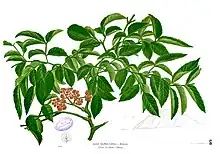Leea
Leea (Tagalog: Talyantan) is a genus of plants in the family Vitaceae, subfamily Leeoideae, that are native to parts of central Africa, tropical Asia, Australia and Melanesia.[1] It was previously placed in its own family, Leeaceae, based on morphological differences between it and other Vitaceae genera. These differences include ovule number per locule (two in Vitaceae and one in Leeaceae), carpel number (two in Vitaceae and three in Leeaceae), and the absence or presence of a staminoidal tube (present in Leeaceae) and floral disc (present in Vitaceae). Pollen structure has also been examined for taxonomic demarcation, though studies have concluded that the pollen of Leeaceae and Vitaceae suggests the families should remain separate while other studies conclude that Leea should be included in Vitaceae.[2]
| Leea | |
|---|---|
 | |
| L. sambucina Blanco, now known as L. rubra Blume | |
| Scientific classification | |
| Kingdom: | Plantae |
| Clade: | Tracheophytes |
| Clade: | Angiosperms |
| Clade: | Eudicots |
| Clade: | Rosids |
| Order: | Vitales |
| Family: | Vitaceae |
| Subfamily: | Leeoideae Burmeist. |
| Genus: | Leea D.Royen[1] |
| Species | |
|
see text | |
The genus was named by Linnaeus after James Lee, the Scottish nurseryman based in Hammersmith, London who introduced many new plant discoveries to England at the end of the 18th century.[3]
Ecology
Leea flowers are visited by a variety of potential insect pollinators, including flies, wasps, bees, butterflies, and beetles. Some species may have evolved synchronized dichogamy as a mechanism to prevent self pollination.[4]
 L. indica fruit and foliage.
L. indica fruit and foliage.
Species
Plants of the World Online accepts the following 45 species in this genus as of 12 July 2023.[1]
- Leea aculeata Blume ex Spreng.
- Leea acuminatissima Merr.
- Leea adwivedica K.Kumar
- Leea aequata L.
- Leea alata Edgew.
- Leea amabilis H.J.Veitch
- Leea angulata Korth. ex Miq.
- Leea asiatica (L.) Ridsdale
- Leea coccinea Planch.
- Leea compactiflora Kurz
- Leea congesta Elmer
- Leea coryphantha Lauterb.
- Leea curtisii King
- Leea cuspidifera Baker
- Leea dentata Craib
- Leea glabra C.L.Li
- Leea gonioptera Lauterb.
- Leea grandifolia Kurz
- Leea guineensis G.Don
- Leea heterodoxa K.Schum. & Lauterb.
- Leea indica (Burm.f.) Merr.
- Leea javanica Blume
- Leea krukoffiana Ridsdale
- Leea longifoliola Merr.
- Leea macrophylla Roxb. ex Hornem.
- Leea macropus Lauterb. & K.Schum.
- Leea magnifolia Merr.
- Leea manillensis Walp.
- Leea nova-guineensis Valeton
- Leea papuana Merr. & L.M.Perry
- Leea philippinensis Merr.
- Leea quadrifida Merr.
- Leea rubra Blume
- Leea saxatilis Ridl.
- Leea setuligera C.B.Clarke
- Leea simplicifolia Zoll. & Moritzi
- Leea smithii Koord.
- Leea spinea Desc.
- Leea suaveolens Merr. & L.M.Perry
- Leea tetramera B.L.Burtt
- Leea thorelii Gagnep.
- Leea tinctoria Lindl. ex Baker
- Leea tuberculosemen C.B.Clarke
- Leea unifoliolata Merr.
- Leea zippeliana Miq.
References
- "Leea D.Royen". Plants of the World Online. Royal Botanic Gardens, Kew. Retrieved 13 July 2023.
- Gerrath, Jean M.; Lacroix, Christian R.; Posluszny, Usher (1990). "The Developmental Morphology of Leea guineensis. II. Floral Development". Botanical Gazette. 151 (2): 210. JSTOR 2995458.
- Sue Shephard (2003). Seeds of Fortune - A Gardening Dynasty. Bloomsbury. p. 11. ISBN 0-7475-6066-8.
- Molina, Jeanmaire (2009). "Floral biology of Philippine morphospecies of the grape relative Leea (Leeaceae)". Plant Species Biology. 24 (1): 53–60. Retrieved 13 July 2023.
External links
 Media related to Leea at Wikimedia Commons
Media related to Leea at Wikimedia Commons Data related to Leea at Wikispecies
Data related to Leea at Wikispecies- Dressler, S.; Schmidt, M. & Zizka, G. (2014). "Leea". African plants – a Photo Guide. Frankfurt/Main: Forschungsinstitut Senckenberg.